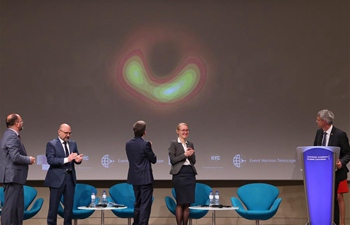MANILA, April 11 (Xinhua) -- An international team of archaeologists have unearthed the remains of a new species of human in the Philippines, providing new direct evidence of early human presence in the country and proving that the region played a key role in human evolutionary history.
The new species, Homo luzonensis, is named after the Philippines' main Luzon Island, where the over-50,000-year-old fossils were found during excavations at Callao Cave located in Penablanca town in Cagayan province in northern Luzon.
The researchers uncovered in 2007 the remains of at least two adults and one juvenile within the same archaeological deposits.
In a news conference at the University of the Philippines in Quezon City on Thursday, Filipino archaeologist Armand Salvador Mijares, who led the project since 2007, described the bones as a "mosaic of primitive (Australopithecus-like) and derived (Homo sapiens-like) morphological features."
A curvature of the foot bone (proximal pedal phalanx) makes it distinctive from those of the other species, he said.
Mijares and the team of researchers said their theory is that the Homo luzonensis are bipedal but could not say if the human species were erect.
"The problem is we only have the foot bone. We did compare it with other primates. And definitely it's a fully bipedal creature. It can walk. Maybe it has better climbing capability than homo sapiens," Mijares said.
More fossils were dug up in 2011 and 2015, he said, adding the new evidence back the existence of the Homo luzonensis and proved that the creatures were "small-bodied Homo sapiens."
"What we can say is that they're small-bodied, how small we don't know. Small because their teeth are very small," he said.
The fossils were determined to be 50,000-67,000 years old, which means the Homo luzonensis predates the Homo sapiens found on Palawan, estimated to be 30,000-40,000 years old.
This would make the Homo luzonensis the earliest human remains to be found in the Philippines.
Mijares said the Homo luzonensis did not live or die in Callao Cave. "The creatures did not die [in Callao Cave]. It was actually washed in the cave. They were actually not using the cave," Mijares said.
"They were just wandering around and they probably died there... the bones washed in the cave," he said.
Mijares said more questions are begging for answers following the discovery of the Homo luzonensis.
"We need to do more work. Digging this time period takes a long time, and perseverance, and patience. It's just the start of what we discovered," Mijares said, expressing hope that the team "will discover more" skeletal remains that will shed light on the issue.
Aside from Mijares, the team of scientists also included Florent Detroit of the National Museum of Natural History in Paris and researchers from the University of Bordeaux, Paul Sabatier University and the University of Poitiers in France, as well as Griffith University in Australia.













